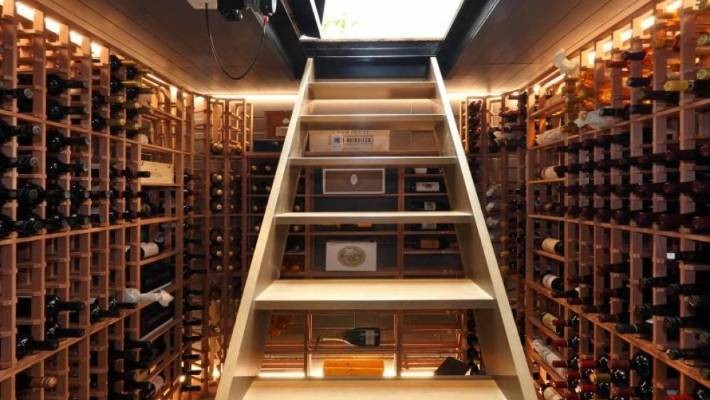Wine cellars and cabinets ‘twice as popular’ as two years ago
JESSOP ARCHITECTS
There are many wonderful ways to store wine. In this Auckland villa, extensively remodelled by architect Darren Jessop, the glass trap door opens up to an extensive wine cellar under the kitchen floor.
It’s official – we are a nation of serious wine aficionados.
Specialists in wine storage and refrigeration systems report rapid growth in sales over the past two years, with some even saying demand is twice as high.
And it seems price is no barrier, with top-quality wine cabinets costing several thousand dollars.
VINTEC TRANSTHERM
Black is currently the most popular colour for wine cabinets. This kitchen features a Vintec 40-bottle wine cabinet and matching beverage centre.
Kitchen designer Damian Hannah of German Kitchens in Wellington says he recently sold two Liebherr full-height, 750mm-wide cabinets to a local client for $19,000, and that is not unusual.
READ MORE
* 10 things you always wanted to know about wine
* Tomorrow’s kitchen today
* Kitchen of the year 2017
GERMAN KITCHENS
This high-end Alno Cera kitchen designed by Damian Hannah of German Kitchens features a Gaggenau 450mm-wide wine cabinet that holds 70 bottles. The cabinet also comes in 600mm widths.
“New Zealanders’ appetite for the best foods and wines is just increasing, and we want to treat foods and wines as they should be treated.
“The tall Liebherr refrigerators have three zones to chill wine at the correct temperature, with champagne and the top, reds in the middle and white wines on the lower shelves. But top-quaity wine cabinets also provide beechwood shelving that holds the perfect temperature, pllus cushion compressors and cone-shaped feet that provide anti-vibration technology. It is proven that vibration, from passing traffic or a washing machine, is not good for wine.”
This wine cellar in a Ponsonby house is accessed through a trap door in the kitchen floor.
German Kitchens acknowledges that space is often an issue, however.
“When we design high-end kitchens for clients, they invariably say they want a big pantry, a big oven and a big refrigerator, which doesn’t leave a lot of space,” says designer Milvia Hannah. “Yet, we are now needing to make room for wine cabinets.”
PETER MEECHAM
The spiral wine cellar in the Ponsonby house lets you see the wine at a glance.
And it’s not just wine cabinets (often called refrigerators). Damian Hannah says underbench cigar humidors ($4500) are also in demand, with clients wanting to store tobacco leaf at the right temperature.
Tony Thomas of wine cellaring specialist Eurocave agrees people are a lot more aware about the need to store wine in the right conditions. “In the past two years, business has doubled,” he says. “The DIY approach doesn’t work. If you dig underground for a cellar thinking you are going to get the right temperature, you won’t. It is just not cold enough, and the temperature will fluctuate.”
Eurocave is frequently consulted on wine cellars, and the company has a spec sheet it gives to builders. “If someone wants to include a wine cellar in their new house, it is best if we can be involved right at the design stage,” says Thomas. “That’s the best way to get a professional result.”
PETER MEECHAM/HOMED
The cellar features white moulded shelving.
Wine cellars and refrigerators have special air conditioning systems to control humidity and temperature. And, with wine cellars usually kept around 12-14 degrees C, a standard heat pump won’t cut it.
Thomas says his company receives a lot of enquiries from the Queenstown region, which he puts down to two key factors.
“Firstly, there are a lot of high-value residential builds in the area, and many overseas buyers who want to build wine cellars into their homes – they want to do it properly. And secondly, there are wild temperature fluctuations in Central Otago. Wine needs to be stored at around 13 degrees, but the temperature there can go down to sub-zero or right up to 40 degrees, and it’s bad for wine to be exposed to those extremes.”
EUROCAVE
This home features a Revelation wine cabinet from Eurocave that can store around 230 bottles at different temperatures as required.
Eurocave also retrofits wine cellars into existing homes. “This market is becoming more prominent. Clients will often have a wine cellar that can store 2000 to 3000 bottles out of the way, and a wine refrigerator in the kitchen right at hand.”
Larger underbench wine cabinets are typically around $5000. But Eurocave’s top seller is a much larger wine cabinet that holds 180 bottles and retails for $14,000. “Our second most popular model is a $5000 underbench cabinet that can hold 50 bottles on five shelves, all at different temperatures.
“People are prepared to pay top dollars for something really good, that has the right aesthetics, as well as the functionality.”
Smaller cabinets are almost de rigeur in high-end kitchens today. Thomas says cabinets that hold up to 18 bottles can be retrofitted under the bench in spaces once occupied by a microwave. These retail for around $3000, and still have the timber shelving and anti-vibration technology.
“Prices can be an issue,” says Damian Hannah. “But the appliance industry is catching up. It’s not just high-end manufacturers, such as Liebherr and Gaggenau – even Fisher & Paykel has introduced several models ($2600 to $4400).”
And there’s another huge trend that offers the best of both worlds for wine and beer drinkers – beverage centres designed to match wine cabinets.
Hannah says wine refrigerators don’t get cold enough for beer, so it usually goes in the normal fridge, or a beer fridge in the garage. But manufacturers have this sorted, also. For example, Liebherr has a beverage centre that looks exactly the same as a wine cabinet, but gets right down to 2degC. And it has metal shelving to suit the temperature.
“Clients love these – and so do their mates who know exactly where to put the beers,” says Hannah.
PERFECT DRINKING TEMPERATURES
Wine storage cabinet specialist Vintec recommends the following temperature guidelines for drinking wine.
* 17-19 degrees: Full-bodied reds (Bordeaux, cabernet, shiraz, zinfandel)
* 14-16 degrees: Lighter-bodied reds (Burgundy, pinot noir, merlot)
* 12-13 degrees: Full-bodied whites (grand cru Burgundy, chardonnay)
* 10-12 degrees: Rose, semillon, viognier, Sauterne
* 8-10 degrees: Riesling, verdelho, vintage Champagne
* 7-8 degrees: Dessert wine
* 6-8 degrees: Sauvignon blanc, pinot gris, non-vintage Champagne

